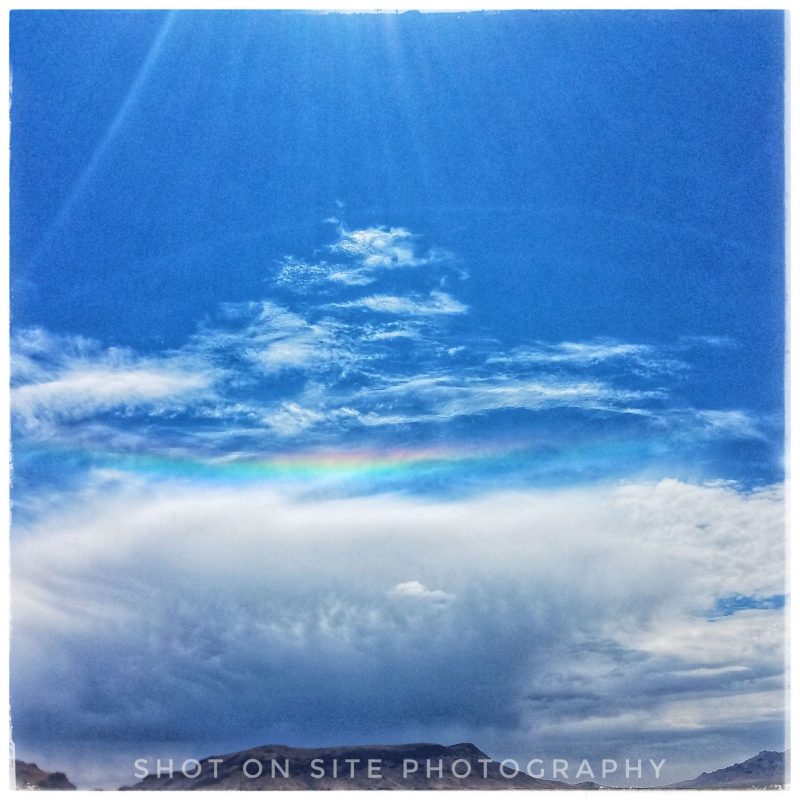

View at EarthSky Community Photos. | Daniel Gauss of Luna County, New Mexico captured this circumhorizon arc with his phone on August 6, 2020.
Daniel Gauss wrote:
Driving home (southbound) happened to look up to view the big cloud and glimpsed this prismatic feature on the leading edge of the cloud. Pulled off the road, and rolled down the window to make sure it wasn’t from the tinted windshield and my sunglasses. Took two shots with the phone. It was high noon, the sun directly overhead. I’m not sure what I’m looking at. Is it the lower portion of a 22° halo? Lower tangent arc? A confused rainbow? Also, what is the faint white line just below the sun’s rays? It seems to complete an oval with the rainbow portion. Tell me great oracles!
Hey, Daniel, the prismatic feature is the easy part. You’re right that it’s not a rainbow, because the sun is above it, and rainbows are always seen opposite the sun. It’s not a 22-degree halo, although – like a 22-degree halo – it’s made by ice crystals. It’s what’s called a circumhorizon arc. More about that below. Now … about that thin white arc above the colored arc. It puzzled us, too. For the answer, we had to go to the true oracle on sky phenomena of this kind – Les Cowley of the website Atmospheric Optics. Les told us in an email:
[The thin white arc between the sun’s rays and the circumhorizon arc] is a camera artifact of some kind. Common when the lens is looking almost toward the sun. The give-away is that it’s so sharp and narrow.
Les also has this to say about circumhorizon arcs on his website:
Near to noon in mid summer is a good time [to see circumhorizon arcs] in middle latitudes. The halo is beneath the sun and twice as far from it (two hand spans) as the 22º halo.
It is a very large halo and always parallel to the horizon. Often only fragments are visible where there happen to be cirrus clouds – the individual patches of cirrus are then lit with colour that can be mistaken for iridescence.
Thank you, Les, and thank you, Daniel!
Bottom line: A photo from the EarthSky community of a circumhorizon arc.
Read more and see more photos: Iridescent cloud? Or circumhorizon arc?
from EarthSky https://ift.tt/33MePyD


View at EarthSky Community Photos. | Daniel Gauss of Luna County, New Mexico captured this circumhorizon arc with his phone on August 6, 2020.
Daniel Gauss wrote:
Driving home (southbound) happened to look up to view the big cloud and glimpsed this prismatic feature on the leading edge of the cloud. Pulled off the road, and rolled down the window to make sure it wasn’t from the tinted windshield and my sunglasses. Took two shots with the phone. It was high noon, the sun directly overhead. I’m not sure what I’m looking at. Is it the lower portion of a 22° halo? Lower tangent arc? A confused rainbow? Also, what is the faint white line just below the sun’s rays? It seems to complete an oval with the rainbow portion. Tell me great oracles!
Hey, Daniel, the prismatic feature is the easy part. You’re right that it’s not a rainbow, because the sun is above it, and rainbows are always seen opposite the sun. It’s not a 22-degree halo, although – like a 22-degree halo – it’s made by ice crystals. It’s what’s called a circumhorizon arc. More about that below. Now … about that thin white arc above the colored arc. It puzzled us, too. For the answer, we had to go to the true oracle on sky phenomena of this kind – Les Cowley of the website Atmospheric Optics. Les told us in an email:
[The thin white arc between the sun’s rays and the circumhorizon arc] is a camera artifact of some kind. Common when the lens is looking almost toward the sun. The give-away is that it’s so sharp and narrow.
Les also has this to say about circumhorizon arcs on his website:
Near to noon in mid summer is a good time [to see circumhorizon arcs] in middle latitudes. The halo is beneath the sun and twice as far from it (two hand spans) as the 22º halo.
It is a very large halo and always parallel to the horizon. Often only fragments are visible where there happen to be cirrus clouds – the individual patches of cirrus are then lit with colour that can be mistaken for iridescence.
Thank you, Les, and thank you, Daniel!
Bottom line: A photo from the EarthSky community of a circumhorizon arc.
Read more and see more photos: Iridescent cloud? Or circumhorizon arc?
from EarthSky https://ift.tt/33MePyD

Aucun commentaire:
Enregistrer un commentaire